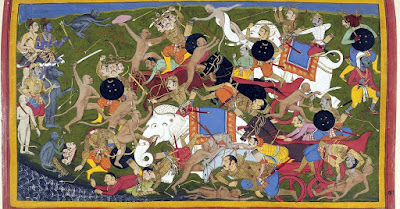THE WHITE MAN'S BURDEN
THE WHITE MAN'S BURDEN
INTRODUCTION
In the backdrop of Philippine- American War( 1899-1902), Rudyard Kipling justifies imperialism, eurocentric racism and the noble enterprise of civilization through industrialization in his poem " The White Man's Burden: The United States and the Philippine Islands"(1899).
Interchanged with poem "Recessional" for the Diamond Jubilee celebration of Queen Victoria's reign ( 1837-1901), Kipling rewrote the poem to exhort Americans to colonize the Philippine Islands conquered from Imperial Spain.
Echoing the related American Philosophy Manifest Destiny, the poem was first published in The New York Sun on 10 Feb 1899. Later, Kipling included the poem in his 1903 collection The Five Nations.
The belief of the Western World that colonization is the way to civilise the Third World made Senator Tillman argue against the Treaty of Paris ratifying the claim of US over the Philippine Island.
THE IMPERIALIST INTERPRETATION AND REACTION
Forcing upon a civilization not suited to the indigenous culture and tradition only begets degradation and a loss of self-respect. "To seek another's profit,/ And work another's gain" is the worst form of dehumanisation.
Kipling proposes to " Take up the White Man's burden", " reap his old reward" and " search your manhood". The moral obligation to " Send forth the best ye breed.... To serve your captives' need" encourages the "well-intentioned" economic, cultural, and social progress in the garb of colonialism. This also points to the philanthropic missionaries in their quest to civilise " new caught...half devil-half-child".
The positive representation of the moral burden of the white race found its opponent in Mark Twain's essay To the Person Sitting in Darkness, 1901: one of the mammoth figures in anti-imperialism, certainly the foremost anti-imperialist literary figure". Kipling's poem also found critical responses in H.T Johnson( an African-American clergy) The Black Man's Burden: A Response to Kipling (1899) wherein the mistreatment of black Americans in the U.S is brought to the forefront. The colonial civilization that Kipling extols has also been countered in Henry Labouchere's ' The Brown Man's Burden' (1899), Ernst Crosby's ' The Real White Man's Burden' (1902) and Hubert Harrison " The Black Man's Burden ( A Reply to Rudyard Kipling)" (1920).
THE SAVIOUR COMPLEX
Kipling's literary work glorifying British colonialism in India and the belief that the British Empire( 1583-1945) was the Englishman's " Divine Burden to reign God's Empire on Earth" eventually combines white saviour with the saviour complex. The concept white saviour complex refers to a white person helping non-white to achieve self-serving goals.
Not only Literature, but the white saviour is also a cinematic trope. Often, a white character rescues a people of colour with the aim of coming across as messianic. Such acts are essentially viewed as narcissistic, especially in Africa which had a long history of slavery and colonisation. Other instances are white families adopting black children (Lion starring Dev Patel), travel to exotic locations (Kurtz in Conrad's Heart of Darkness) etc. Also, Malala Yousafzai's removal from Pakistan for treatment is an example of 'white saviour complex'.
ALBERT MEMMI- THE COLONIZER AND THE COLONIZED
Published in 1957, Memmi's best non-fiction work talks about the interdependent relationship of the two groups. It describes the psychological effects of colonialism on colonizer and colonized, oppressor and oppressed. The book was followed by Dominated Man, Dependence, and Racism.
The Colonizer and the Colonized is often read in conjugation with Frantz Fanon's The Wretched of the Earth, Black Skin, White Masks and Aime Cesaire's Discourse on Colonialism.



Comments
Post a Comment